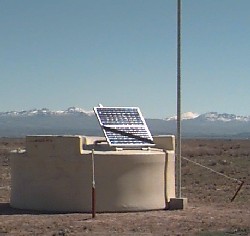Black Holes from Heaven
Some of the most enticing “theories of everything” require the existence of extra dimensions beyond the three we can perceive. These dimensions might be “curled up” to a small size we wouldn’t notice. But they might allow energetic colliding particles to collapse into microscopic black holes that are detectable. Researchers have expected to wait until late in the decade for the first possible glimpse of these exotic objects, but according to the 14 January print issue of PRL, cosmic ray experiments scheduled to begin in the next few years have the potential to finger them.
Cosmic rays–high-energy protons, neutrinos, and other particles–continually rain down through the atmosphere from parts unknown. When a cosmic particle hits an atmospheric proton or neutron with sufficient force, the pair can explode into cascading showers of particles kilometers across. Or, if it’s extremely energetic, the ray could create a tiny black hole, which arises when matter becomes ultra-concentrated. Theory predicts these space-time sinkholes should then decay into a wide array of products, from muons to photons.
For miniature holes to form, the colliding particles must get so close that the gravitational force between them is strong relative to the other forces. This distance is near the so-called Planck length, which in the standard theory of gravity is cm. The energies required to form such black holes are far out of reach of the most powerful accelerators and cosmic rays. But if higher dimensions exist and are relatively large, the Planck distance would increase, and the energy requirement would fall. “These black holes appear to be one of the most spectacular predictions and one of the most incisive probes” of large extra dimensions, says Jonathan Feng of the University of California at Irvine and MIT.
Feng worked with Alfred Shapere of the University of Kentucky in Lexington to calculate the likelihood that cosmic ray black holes could be created and detected. In their PRL paper they consider the Auger cosmic ray observatory, which will combine a array of particle detectors with a series of fluorescence detectors trained on the sky. Cosmic neutrinos should provide the clearest evidence of a black hole, Feng explains, because these weakly interacting particles can survive deep plunges into the atmosphere, where there’s less background from ordinary cosmic ray showers. So he and Shapere suggest that Auger look for black hole signatures specifically from particles that have gone a long way through the atmosphere.
If large extra dimensions do exist, the calculations predict that Auger should record tens to hundreds of showers from black holes in its first few years of operation, starting around 2004. “It would be such a revolutionary discovery that I’m not pinning all my hopes on it,” Shapere remarks. Indeed, he adds, even the lack of these showers would have value in limiting the possible sizes of any higher dimensions. Physicists had not expected the chance to test for these black holes before the Large Hadron Collider at CERN in Geneva turns on later this decade.
The new analysis is a sound way to test an unattractive idea, says MIT’s Frank Wilczek. The large extra dimensions hypothesis clashes with some well-established concepts, he notes. “Feng and Shapere have demonstrated, I think quite convincingly, how study of high-energy cosmic ray showers can be an effective way of disproving–or, heaven help us, establishing–the hypothesis.”
–JR Minkel
JR Minkel is a freelance science writer in New York City.



